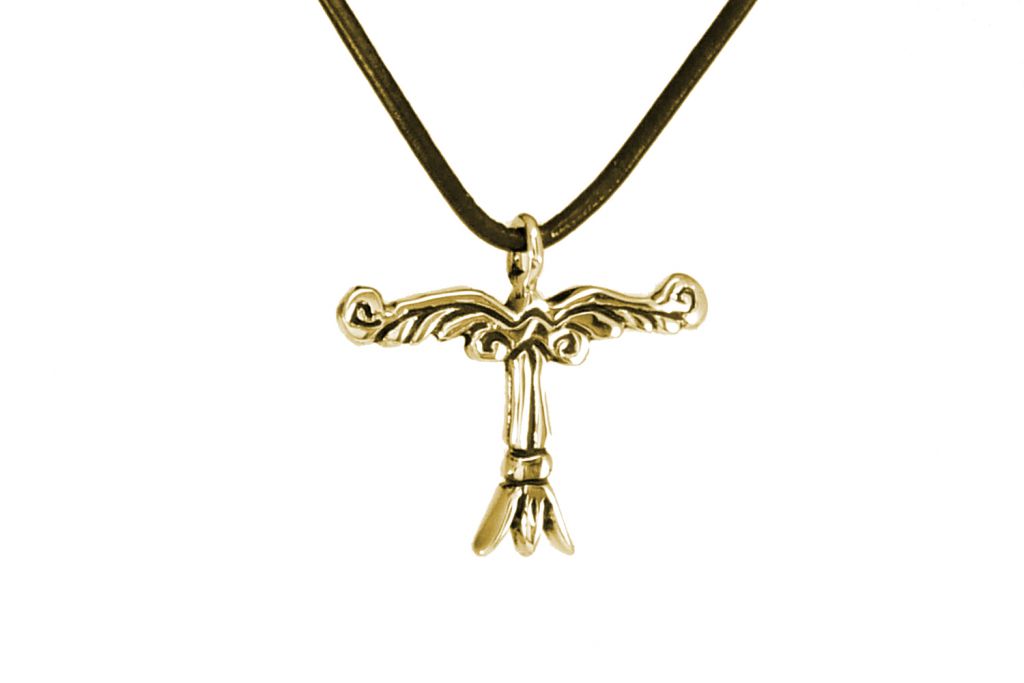Small Irminsul Pendant, Gold
Pendant of the irminsul, a cultic pillar in shape of a tree, as depicted at a relief at the rock formation of the Externsteine, Germany
Irminsul Pendant
Size of the Irminsul pendant approx. 28 x 25mm, handmade from solid gold! Supplied with leather thong and certificate.
It took Charlemagne over thirty years to begin integrating the Saxon tribes into his Frankish empire from 772. Under the pretext of Christianising the pagan Saxons, power-political interests were enforced with the sword. During two major campaigns, Charles destroyed the great central sanctuary of the Saxons, the "world column" Irminsul, near Eresburg (Obermarsberg).
However, the Saxons resisted in the years to come under the leadership of Prince Widukind and devastatingly defeated the Frankish army at the Süntel. Charles' missionaries, who were already spreading the Christian faith near the Lower Weser river, were also slain.
Charlemagne's counterattack ended with the "Blood Court of Verden", which is reported in the Einhard Annals and the Imperial Annals from the Lorsch Monastery. Over 4500 rebellious Saxon warriors and nobles are said to have been executed as a deterrent. Widukind, who had fled to Denmark, later returned and adopted the Christian faith.
The origin of the Irminsul is possibly to be seen in the cultic worship of the world tree Yggdrasil, which plays a central role in Germanic mythology. Irmin, Tiu to the Scandinavians, was a son of Wotan (Odin). As god of war and protector of the Thing, the assembly of all free men, he experienced great veneration.
Irminsul - Our pendant
What the central sanctuary of the Germanic Saxons, the Irminsul, looked like remains an open question. The trail leads to another site that is still a centre of attraction for many Germanic enthusiasts today. While archaeologists shrug their shoulders and point out that the earliest finds date back to the High Middle Ages, the Externsteine to the west of Horn-Bad Meinberg remain an ancient cult site of pagan Germanic prehistory to common opinion.
Independently of this, remains of an old hermitage can be found in the rock of the Externsteine. From the 11th century onwards, Christian monks began to carve living and prayer grottos into the rock. A huge rock relief, 5.50 m high, also dates from this time. It shows the descent of Christ from the cross with several figures, a dragon and a bent tree, possibly a date palm (picture). Therefore, it is rather unlikely that there is actually a contextual reference to the Irminsul here.
The interpretation of the depiction of the bent tree as a Christian triumph over paganism was largely adopted without criticism. The tree was interpreted as a bent Irminsul and the dragon as a world serpent, the symbol of earth forces.
Even though the actual appearance of the Irminsul is unknown and the motif of the Externsteine has no relation to the Irminsul, this representation is still very popular today and is considered a symbol of the Germanic religion itself, especially among followers of Asatru.
| Delivery time | 3-4 weeks |
|---|---|
| weight | 0.004000 |
| size | 28 x 25 mm |
| Era | Germans |
| Material | Gold |
| Kind of replica | Pendants |
| scope of delivery | Delivery in a jewellery case with leather necklace and certificate |

